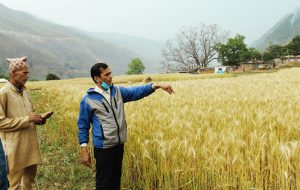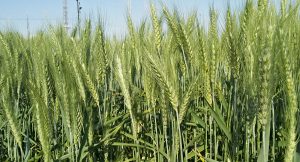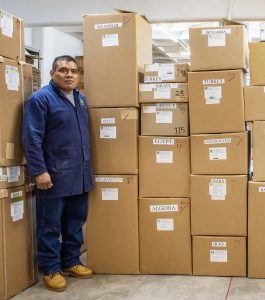Bright horizons for biofortification
Nepal is one of the many countries starting to reap the health benefits of biofortified crops

In most grocery stores, bread packaging labels will often tout the nutrients that the flour has been enriched with. In its natural form, wheat can carry essential nutrients, such as zinc and iron, but declining soil health and harsher climates are making crops less nutritious. In many developed countries, commercial flour mills add those and other micronutrients, or industrially fortify flour, so that wheat products are more nutritious.
In Nepal, farmers collectively produce nearly two million tons of wheat each year. Most of them are smallholders with less than one hectare of land. In remote regions, families consume wheat products, such as chapati, roti, momo dumplings, and noodles made from grain that is known to be low in essential micronutrients, contributing to poor nutrition in the areas.
“The tendency to consume wheat directly on the farms and in the communities where it is grown means that fortified wheat from commercial mills is unlikely to reach poor rural communities,” said Velu Govindan, a senior scientist and wheat breeder at the International Maize and Wheat Improvement Center (CIMMYT).
Research has shown that food security improvements in Nepal over the last several decades can be accredited in part to rising cereal production. Although the situation is improving, malnutrition is still considered a major issue in rural subsistence populations. According to the Global Hunger Index 2019, 36% of children in the country suffer from stunting, an indicator of chronic undernutrition.
This is an important reminder that a simple increase in food availability does not guarantee the population is getting the nutritional content needed to break out of the poverty cycle — a growing issue known as “hidden hunger.” In addition, most of the popular wheat varieties grown in the country have become vulnerable to increasing climatic stresses, new types of wheat diseases or virulent strains of the existing pathogens.
Start with the seed

Huge strides are being made in the world of crop breeding to improve the nutrient quality, yield, and other farmer-preferred traits of staple grains. Now, the seeds themselves can be an agent for an integrated food systems transformation.
Biofortification — the development of micronutrient-dense staple crops through breeding — has become a powerful tool in combating hidden hunger.
Using conventional breeding methods, CIMMYT has become a leader in the development of biofortified maize and wheat.
The future is looking brighter
In 2020, CIMMYT worked with the Nepal Agricultural Research Council (NARC) to develop what ended up being a historic release of six new wheat varieties in the country. Five of them were biofortified, developed by crossing modern high yielding wheats with wild relatives that are nearly 20-40% higher in zinc and iron content than local commercial crops. In addition, these varieties were superior in yield and resistance to prevalent diseases compared to existing varieties.
“Biofortification of staple crops such as wheat is a proven method to help reverse and prevent zinc deficiency, especially for those without access to a more diverse diet,” said Arun Joshi, CIMMYT regional director for South Asia.

The five new biofortified varieties — Bheri-Ganga, Himganga, Khumal-Shakti, Zinc Gahun 1 and Zinc Gahun 2 — and wheat blast-resistant variety Borlaug 2020 were developed in a “fast-track” approach. The team of NARC scientists was led by Dhruba Thapa at Khumaltar, who focused on the mid- and high-hill regions, and Roshan Basnet at the National Wheat Research Program in Bhairahawa, who focused on the Terai plains.
The scientists introduced, tested and identified the best varieties from trials sourced from CIMMYT’s biofortified wheat breeding program with support from Madan Bhatta, a CIMMYT consultant in Nepal. With these varieties, farmers in all wheat growing regions of Nepal will be able to reap enormous benefits.
“This is an especially impressive achievement by the NARC breeders and technicians during a time of COVID-related challenges and restrictions,” said NARC Executive Director Deepak Bhandari. Large-scale seed production is now underway for distribution to farmers for the 2021-22 wheat season.
The varieties are tailored for the environmental conditions of a range of wheat growing regions in the country, including tolerance to diseases and heat stress. Breeders also considered processing quality, to create a diverse range of wheat-based food products.
Setting targets and hitting the mark

Biofortified wheat has several potential advantages as a delivery vehicle for micronutrients in diets, in South Asia and beyond. Since 2019, a project led by CIMMYT (Accelerating the Mainstreaming of Elevated Zinc in Global Wheat Breeding) aims to mainstream biofortification as a breeding standard. Scientists are following a population-wide approach, like adding fluoride to tap water. The support of funders and national partners enabled the release of the new varieties in Nepal in record time.
“Within 10 years, it is expected that at least 80% of all new wheat lines from the CIMMYT pipeline targeted for release in Asia, Africa, and Latin America will have higher levels of zinc. Given CIMMYT’s predominance as a global improved wheat breeding germplasm supplier, people who consume wheat products in developing countries will benefit from substantially increased levels of dietary zinc,” explained Ravi Singh, head of wheat breeding at CIMMYT. Since zinc and iron are highly correlated genetically, these efforts are simultaneously increasing iron content in the grain.
In a recent interview with Reuters, Director General Martin Kropff explained how CIMMYT is already working to “mainstream” biofortified maize and wheat into global seed supply, with major releases already underway in Bangladesh, Colombia, India, Mexico, and Pakistan, in addition to Nepal.
“This is something that is starting in a big way this year,” said Kropff in the exclusive interview.
Zinc wheat is currently grown by over one million households across South Asia, benefiting an estimated three to four million household members. Thanks to CIMMYT’s strong partnerships with national agricultural research systems, sustainable and cost-effective biofortified seeds will make their way to the farmers and consumers who need them most.
Partners and funders
Asian Development Bank (ADB), Bill & Melinda Gates Foundation, Foreign, Commonwealth & Development Office (FCDO) of the United Kingdom, HarvestPlus, and Nepal Agricultural Research Council (NARC).